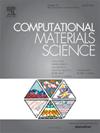Investigating vacancy-defect effects on the vibration characteristics of graphene resonators with molecular dynamics simulation
IF 3.1
3区 材料科学
Q2 MATERIALS SCIENCE, MULTIDISCIPLINARY
引用次数: 0
Abstract
Due to the limitations of graphene processing technology, the as-prepared graphene will inevitably have various defects, which will have remarkable effects on the macroscopic properties of graphene. In this work, graphene resonators based on vacancy defects are investigated. The resonance properties of graphene are demonstrated by molecular dynamics simulations, in which the effects of single and double vacancy defects at different positions and numbers on the resonant frequencies of graphene nanoribbons are unveiled. The results show that the C atoms at the vacancy defect have a much larger movement in the normal direction than in the region of C atoms bound by a complete C–C bond. The resonant frequency is not affected by the location of vacancy defects. As the number of vacancy defects increases, the resonance amplitude value increases monotonically in the normal direction. However, there is no significant difference in the resonance amplitude value when comparing single and double vacancy defects. The resonant frequency decreases monotonically with the increase in the number of vacancy defects, while for the same number of vacancy defects, the resonant frequency is generally smaller for double vacancy defects than for single vacancy defects. The resonant frequency is not sensitive to individual single and double vacancy defects rather than is more affected by a large concentration of vacancy defects, suggesting that extra attention needs to be given to the case of large concentration defects. Our achievement will lay a strong foundation for graphene resonators’ design and performance optimization.

求助全文
约1分钟内获得全文
求助全文
来源期刊

Computational Materials Science
工程技术-材料科学:综合
CiteScore
6.50
自引率
6.10%
发文量
665
审稿时长
26 days
期刊介绍:
The goal of Computational Materials Science is to report on results that provide new or unique insights into, or significantly expand our understanding of, the properties of materials or phenomena associated with their design, synthesis, processing, characterization, and utilization. To be relevant to the journal, the results should be applied or applicable to specific material systems that are discussed within the submission.
 求助内容:
求助内容: 应助结果提醒方式:
应助结果提醒方式:


